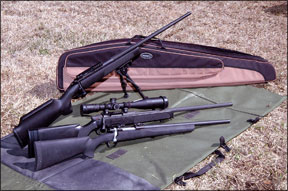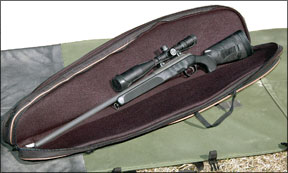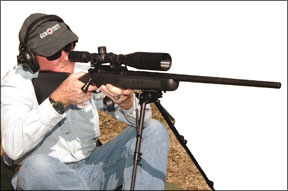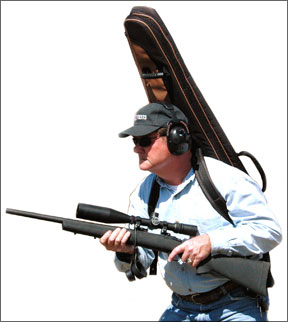Tactical bolt-action rifles are pretty easy to spot. Typically, they utilize a composite stock with pronounced pistol grip, oversize bolt handle and fire from a heavy barrel. The military models are camouflage or earth tone in color, and the law-enforcement models are usually black. Accuracy, strength, and simplicity are key attributes. Can a tactical rifle serve as a hunting rifle? Were not saying one cant. Its just that a tactical rifle typically weighs more than a hunting model. The heavy barrel enhances the ability to maintain accuracy throughout repeat fire and excessive heat. In addition, tactical rifles tend to be more suitable for longer distance shots and offer ergonomics that favor the prone position or other means of support. Compared to hunting rifles that feature adornments such as engravings or fancy wood, the tactical rifle is stark and businesslike. In this test we evaluate three rifles chambered for 308 Winchester aimed at the law-enforcement market. Our three test rifles are the $1315 Kimber 84M LPT, the $1899 Steyr Arms SSG69 PII, and Rugers $1172 Hawkeye Tactical No. HM77VLEH. All three rifles featured full-float barrels and black synthetic stocks. Our test procedure was straightforward. Shooting from bench support we fired groups at paper targets placed 100 yards downrange. Beyond accuracy data, we judged each rifle as a total package after taking careful note of characteristics displayed by the trigger and the bolt. We also wanted to know how willingly each rifle took to the shoulder and related to a variety of support. Each rifle was fired from sandbags, a mechanical rest, from prone position and seated with bipod support.

When it came to choosing optics for our test, we weighed the advice of one staffer who had taken the position that he would rather own one good expensive scope than have several lesser optics, so we shot all the guns with a $1783 Nightforce 5.5-22X50mm NXS scope (www.nightforceoptics.com). Fitted with an illuminated mil-dot reticle, this scope has been in use by one of our long-range specialists for more than two years. The open-face mil-dots, which appear as small loops, have proven helpful when determining elevation for targets at an undetermined distance. We mounted the 31-ounce scope using 30mm Nightforce rings fit with half-inch bolts. The use of a 65-inch-pound torque wrench made fast work of swapping the scope from one rifle to another.
Test ammunition included three selections of factory ammunition. We recorded five-shot groups firing Remington 180-grain Nosler Partition No. PRP308WB, Remington 168-grain Boat Tail Hollow Point Match No. R308W7, and 175-grain Boat Tail Hollow Point rounds from Black Hills Ammunition. Making use of the powerful Nightforce scope, we were able to use small target dots from Birchwood Casey measuring little more than 1 inch across. We also fired three-shot groups of some of our favorite handloads developed for lower recoil and accuracy at moderate distance. Our handloaded ammunition consisted of filling each cartridge case with an identical charge of IMR 4064 powder atop Winchester Large Rifle primers. We then seated three different bullets from Sierra (www.sierrabullets.com). They were the 165-grain Spitzer Boat Tail bullets No. 2145, 165-grain boat tail hollow points No. 2140, and the 150-grain Spitzer bullets No. 2130. Each rifle was fired to produce a single three-shot group with each handload. Weather conditions varied during our 9 a.m. to noon sessions, with calm winds in the morning and gusts exceeding 10 mph toward midday. Each rifle was treated to a break-in regimen of one shot and clean; two shots and clean; three shots, clean; four shots, clean; and finally five shots and clean. With little interference from the weather, we think we were able to accurately assess each of our test rifles. We think each of our test rifles was exceptional divided primarily by shooter preference. Lets shoot each rifle and see which one might be your favorite.
Steyr Arms SSG69 PII 308 Winchester, $1899
Its flat-black Parkerized 25.6-inch barrel was the longest of the trio, and its muzzle was double-crowned, recessed and polished. The outer edge of the muzzle was beveled about 45 degrees. This contour was designed to reduce the chance of foliage grabbing on and perhaps fouling the bore. The top of the Parkerized steel action was milled to accommodate a quick detachable scope mount (supplied). The bolt handle was oversized, and the throw was short and positive. The action was housed in a one-piece synthetic stock that was understated if not somewhat ominous in appearance. It gave off a hollow sound when we tapped on it. But before we could be turned off by this characteristic, we began to appreciate what this stock had to offer. The sides of the stock from the inlet for the bolt handle forward were nearly vertical. Checkering was molded in along the first 10 inches of fore end. The barrel was distinctively floated, leaving a gap of about 0.10 inches between the fore end and the barrel. The tip of the fore end was fit with a sling loop that swiveled a full 360 degrees beneath the barrel. The bottom side of the fore end was fit with an internal rail suitable for mounting another sling stud or attachment for a bipod. The rail was long enough to mount multiple accessories. Given the long barrel, we think the SSG69 PII was the best bet for some really long shots, and this rail could also be used to mount a thumb stop for competitive shooting.
The Steyr rifle fed from a detachable box magazine that held five rounds. Its rotary design made it compact and allowed it to fit flush with the bottom of the stock. The sides of the magazine were clear so we could count the amount of rounds inside. The magazine could be snapped into place or the release tabs could be pressed as the magazine was inserted

for silent loading. The magazine-release tabs were located on the magazine itself and not on the receiver. One magazine was supplied, but extras can be purchased from www.steyrarms.com for $69 each.
The pistol grip was liberally checkered, flaring outward at the cap on the lower end. The comb of the buttstock was flat rather than raised and neutral in profile from the comb downward. But the left side of the stock was relieved with a channel and connecting point for a sling. A sling the width of one inch or less should fit flush, but this could still interfere with the cheek of a right-handed shooter. The buttpad consisted of a plastic mount covered by a thin convex layer of rubber. Nevertheless, we rated shock absorption as being adequate. Beneath the buttpad were three shims that meshed to produce a maximum length of pull (LOP) measuring about 13.8 inches. Each shim added about 0.33 inches to LOP. We tried removing all three shims and replacing the buttpad, but the two slot head screws that held the butt pad in place were too long and protruded from the rear. Shorter screws were not supplied, so a trip to the hardware store would be called for to solve this.
The safety was located directly behind the arm of the bolt on the righthand side of the receiver. It had a rather long, hard throw to it, at least before any break-in that might ease its movement. The motion was back for Safe, exposing a white dot, and forward to Fire, leaving a red dot visible on the receiver. The rear half of the lever-face was lined and raised to accept being pushed. The forward half was scalloped to create a hook-like surface so it could be pulled more easily to the rear. Safety-on not only seized the trigger but also locked down the bolt. Once in action, movement of the bolt was piston like, short and smooth. There was really no way to be sloppy with this bolt or bind its motion by jerking it up, down, or side to side. Removing the bolt required dropping the magazine and clearing the chamber. With the safety in the fire position, the bolt was pulled to the rear. Pressing the trigger released the bolt. Installing the bolt was as simple as re-inserting it into its channel.
The Steyr featured a two-stage trigger which, as delivered, presented about 3.75 pounds of resistance. The weight of the trigger pull could be adjusted by turning a screw located directly behind the trigger. The owners manual warns that too light a trigger pull may cause unintentional discharge. The amount of slack in the take-up of the trigger can also be adjusted by turning the screw located on the front of the trigger. Too little slack could also produce an unintentional discharge. We liked the trigger as delivered. There was plenty of feel and feedback from the moment of taking up slack to the point of let-off.
It is common to point to characteristics such as rate of barrel twist when explaining that one rifle or another is better with say, lighter bullets rather than heavy ones. Certainly the Steyr hammer-forged barrel did its job, but we think the consistent trigger rich with feedback was the reason why all three of our factory-loaded rounds with bullets ranging in weight from 165 grains to 180 grains produced five-shot groups measuring between 0.8 inches and 0.9 inches across. Our handloaded ammunition did underline the Steyrs preference for medium- to heavier-weight bullets. The 150-grain bullets printed about a 1.2-inch wide group on average. But our 165-grain handloads delivered groups measuring 0.5 inches and 0.6 inches across.
Our Team Said: The SSG69 PII offered sophistication and simplicity all in the same rifle. A bottom rail suitable for a light or sling or even a thumb stop provides versatility. A flushfit removable magazine, short-throw piston-like bolt and little things like a usable contour applied to the safety are the types of features that professionals appreciate. The long barrel helps produce additional velocity, favoring longer distance applications.
Kimber 84M LPT 308 Winchester, $1315
The Kimber 84M LPT (Light Police Tactical) rifle is a weapon that makes an immediate visual impression. The black synthetic stock was solid with a matte pebbled finish. The fore end and pistol grip were knurled to improve grip. This pattern camouflaged the block letters LPT along the fore end. Our Kimber rifle was built for right-handed shooters. The oversize pistol grip was further enhanced by a palm swell on the right side. The left side of the comb was built up, offering a broad expansive wall on which to rest the cheek. But the right side of the comb was abbreviated, producing a sharp edge for the left-handed shooter. As we went to press we learned that the 2010 84M LPT models would feature a neutral

profile to its comb and butt stock. It just so happened that our test shooter, an accomplished NRA High Power competitor, was left handed. He did not find this bias difficult to overcome but remarked that the change to a neutral profile stock was welcome news.
The bottom of the stock was fit with one sling stud to the rear and two sling studs up front. These can be used to attach a bipod on one and the top of the sling to the other. The right side of the stock was relieved for the bolt handle, but the knob was oversize, tapering to one full inch at the end cap. A five-round internal magazine with floor plate release located inside the trigger guard at the lower end of the forward arc capped the bottom of the action. Above the action was a sturdy, clean-looking one-piece scope mount. At first our staff reported that it took some extra care to load the rifle on a single round basis because of the way the scope mount crossed the breech. But another member of our staff who does a lot of Practical Pistol competition remarked that it reminded her of a magazine well. Indeed, the center of the mount did not simply lie horizontally across the opening. Instead it offered a smooth 90-degree arch that could be used to guide the round into place. To illustrate, we found it possible to tilt the rifle with the bolt closed, chamber empty, place a fresh round on top of the bolt and load the breech by pulling back the bolt. The round would roll off the underside of the mount and fall into place ahead of the bolt. We doubt this procedure will find its way into the owners manual but it might show up in a movie someday.
The bolt had a moderately long throw, but the huge bolt handle gave us plenty of leverage, enough to make it fun. A three-position safety was mounted on the right. Swept fully to the rear, it locked both the trigger and the bolt. The intermediate position prevented the trigger from moving but allowed the bolt to be manipulated. With the safety pushed fully forward, the rifle was ready to fire. Despite weighing just 5 ounces less than the Steyr rifle, the barrel of the Kimber was only about 1.6 inches shorter. This is because the Kimber LPT varied from the standard Tactical profile by working through a Sporter style barrel. This means that the barrel was tapered from the receiver to its smallest diameter at the muzzle. In addition, the surface of the barrel was fluted. By milling indentations into the surface of the barrel that run lengthwise over the bore the barrel not only becomes lighter but introduces more surface area from which to disperse heat. The crown of the barrel was recessed only by the subtle convex profile at the front of the barrel. The most remarkable aspect of this 9.2-pound rifle was its balance. It felt like the lightest weight rifle in the test.
The trigger on our Kimber was the only single-stage action among our three rifles. The face of the trigger was highly polished, and its tight arc seemed to grab our trigger finger. There was no take-up in this trigger, just a crisp snap. Although it weighed in at 3.0 pounds, we think this is the kind of trigger we hope to obtain when we send a rifle to a top custom gunsmith. According to the owners manual the trigger is adjustable for over travel, depth of sear engagement and weight of pull. But the manual does not instruct how to make adjustments and warns against changing the factory setting. We dont think the trigger could be improved anyway. We wondered if the trigger would pay off at the shooting bench and if there would be any adverse effect such as vibration from the narrow profile barrel. Our handloading team remarked that barrel vibration is a characteristic that can be taken into account when preparing ammunition. But we neednt have worried.
Our handloads delivered groups of 0.4 inches, 0.5 inches and 0.6 inches respectively for the 165-grain Boat Tail, 165-grain Boat Tail Spitzer, and 150-grain Spitzer bullets from Sierra. The Kimber showed a distinct preference for the 168-grain Boat Tail hollow points from Remington, averaging just over 0.7 inches across for five shots. Given the 1:12 inch twist to the barrel we might have predicted these results in comparison to our test ammunition topped with heavier bullets. Our 175-grain and 180-grain factory loads produced groups that averaged about 1.1 inches across. Modern law enforcement rounds typically featuring light to moderate weight bullets should excel in the Kimber LPT rifle.
Our Team Said:The superb balance of the 84M LPT made this 9-pound rifle much easier to handle. The stock featured the best pistol grip, and we loved the texture of the synthetic material. Five-round internal magazine capacity should satisfy those who would prefer a removable magazine. The latest version of this rifle will forego the bias of a one-sided raised comb. Hopefully the super match-quality single-stage trigger will remain.
Ruger Hawkeye Tactical No. HM77VLEH 308 Winchester, $1172
Of our three rifles the Ruger Hawkeye Tactical cut the most familiar profile. But that doesnt mean it was plain. The Ruger was fit with a true bull barrel measuring 20 inches in length. The muzzle was double crowned and recessed about 0.035 inches. The outer edge of the barrel was beveled. The barrel and receiver are listed on the www.ruger.com website as being finished in Hawkeye Matte Blue, but these parts were a match for the black color of the stock. The receiver was machined with a proprietary scope base for fitting a set of Ruger scope rings, which were supplied. The bottom of the receiver was capped by a hinged floor to provide secondary access to the four-round magazine. The Ruger logo was imprinted in a shiny hologram-type etching on the floor plate. The floorplate release was located outside the trigger

guard. We found it somewhat difficult to press, but once the release was pushed, your finger was in position to hold the spring-loaded floorplate in check. This gave us the ability to control the floorplate and catch the rounds as they dropped. In this way, unloading the magazine could be performed with one hand.
The bolt, bolt handle, and trigger were each satin stainless in color. The bolt release was a lever to be pulled outward from the left side of the receiver. The hinge was rearward so you reached to the front of the lever to operate it. The safety was located on the right to the rear of the bolt handle. This entire area was also colored Hawkeye matte blue. As a result the vertical line of the satin stainless bolt handle created a distinctive accent. The safety operated in three positions, including forward to fire and fully rearward to lock down the bolt and seize the trigger. The middle position held the trigger in check but allowed the operator to work the bolt. The bolt handle itself was flattened and much of it, save the ball on the end, was seated well below flush with the side of the stock.
Perhaps the most notable feature of the Ruger Hawkeye Tactical rifle was its stock. This was the Hogue Overmolded stock (www.getgrip.com). The Overmolded stock consists of three main components. A rigid fiberglass reinforced skeleton to suit the action, aluminum pillar bedding, and a synthetic elastomer (rubber) that is ejection molded to form the outer shape. Hogue offers this technology for several types of rifles including the Ruger Minis and the AR-15 as well as bolt-action models. The stock on our Hawkeye Tactical featured Hogues exclusive cobblestone texture applied to the pistol grip and along the fore end area. But we found the Overmolded material provided enhanced grip without being tacky throughout its entire surface. Dual sling studs were mounted up front and a single stud to the rear. The buttpad was the thickest and far and away the most effective among our three rifles. The most comfortable rifle to shoot, we think the entire body of the Overmolded stock helped absorb recoil. The overall feel of the gun was short and maneuverable.
At the range we learned that the Hawkeye Tactical had a very nice two-stage trigger, breaking at about 3.5 pounds. This was the Ruger LC-6 trigger. No mention of adjustability was made in the owners manual and no point of adjustment was visible. The bolt action was quite long and not as smooth or as steady as we would have liked. Once the bolt was fully to the rear it could be moved up and down or side to side. The key to a smooth stroke was not to forcibly tug it fully to its stop. Once the bolt face passed the bolt opening, we learned to let momentum carry it the final inch of throw. This technique helped us avoid moving the bolt off its true horizontal path. Relying upon wrist motion instead of arm strength helped us cycle the Ruger much faster. But its what happens when the bolt is closed that really counts.
Remingtons 168-grain Boat Tail hollow point match was the top factory round overall with a 0.4 inch group. Average group size for this round was computed to little more than 0.6 inches. The Hawkeyes barrel was rated at a 1:10 inch twist. This generally favors heavier bullets, but the Black Hills 175-grain bullets produced a 1.1 inch average and the 180-grain Remington rounds averaged 0.7 inches. Our handloads gave us the best results. The 150-grain Sierra Spitzer rounds produced a 0.6 inch group and the 165-grain Sierra BTHP rounds landed in a 0.5 inch pattern. The best overall group of the test was nearly one hole. Hits from the 165-grain Sierra Spitzer Boat Tail slugs formed an elliptical pattern measuring about 0.2 inches across. The Spitzer is a popular hunting bullet so that underscores our assertion that a good tactical rifle can serve as a good hunter as well.
Our Team Said: We had to pay more attention to cycling the bolt to move quickly, but the accuracy provided by the Hawkeye Tactical was superb. Credit the smooth LC-6 two-stage trigger and the short, heavy barrel featuring 1:10 rate of twist. The Hogue Overmolded stock reduced recoil substantially and made it look easy, too. Adding a removable magazine system was our only wish. The short overall length of the Hawkeye Tactical likely makes it the best choice for keeping in the back of the patrol car.
0410-RUGER-HAWKEYE-TACTICAL.pdf





























